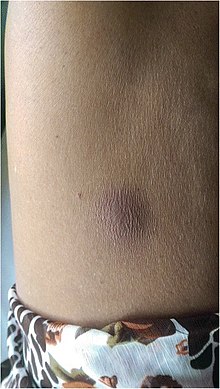Melioidosis
Halaman ini sedang dipersiapkan dan dikembangkan sehingga mungkin terjadi perubahan besar. Anda dapat membantu dalam penyuntingan halaman ini. Halaman ini terakhir disunting oleh Hanamanteo (Kontrib • Log) 911 hari 705 menit lalu. Jika Anda melihat halaman ini tidak disunting dalam beberapa hari, mohon hapus templat ini. |
| Melioidosis | |
|---|---|
 | |
| Bisul melioidosis di perut | |
| Informasi umum | |
| Spesialisasi | Penyakit menular |
| Penyebab | Burkholderia pseudomallei spread by contact to soil or water[1] |
| Faktor risiko | Diabetes mellitus, thalassaemia, alcoholism, chronic kidney disease[1] |
| Aspek klinis | |
| Gejala dan tanda | Tiada, demam, radang paru-paru, beberapa bisul[1] |
| Komplikasi | Encephalomyelitis, septic shock, acute pyelonephritis, septic arthritis, osteomyelitis[1] |
| Awal muncul | 1-21 hari setelah terjangkit[1] |
| Diagnosis | Growing the bacteria in culture mediums[1] |
| Kondisi serupa | Tuberculosis[2] |
| Tata laksana | |
| Pencegahan | Prevention from exposure to contaminated water, antibiotic prophylaxis[1] |
| Perawatan | Ceftazidime, meropenem, co-trimoxazole[1] |
| Distribusi dan frekuensi | |
| Prevalensi | 165,000 people per year[1] |
| Kematian | 89,000 people per year[1] |
Melioidosis adalah penyakit infeksi yang disebabkan oleh bakteri Gram-negatif bernama Burkholderia pseudomallei.[1] Kebanyakan orang yang dijangkiti Burkholderia pseudomallei tidak mengalami satupun gejala, tetapi mereka yang mengalami gejala memiliki tanda dan gejala seperti demam, perubahan kulit, radang paru-paru, dan bisul, hingga radang otak, radang sendi, dan tekanan darah rendah yang berbahaya yang menyebabkan kematian.[1] About 10% of people with melioidosis develop symptoms that last longer than two months, termed "chronic melioidosis".[1]
Humans are infected with B. pseudomallei by contact with polluted water. The bacteria enter the body through wounds, inhalation, or ingestion. Person-to-person or animal-to-human transmission is extremely rare.[1] The infection is constantly present in Southeast Asia, particularly in northeast Thailand and northern Australia.[1] In developed countries, such as in Europe and the United States, cases of melioidosis are generally imported from countries where melioidosis is more common.[3] The signs and symptoms of melioidosis resemble tuberculosis and misdiagnosis is common.[4][2] Diagnosis is usually confirmed by the growth of B. pseudomallei from an infected person's blood or other bodily fluid.[1] Those with melioidosis are treated first with an "intensive phase" course of intravenous antibiotics (most commonly ceftazidime) followed by a several-month treatment course of co-trimoxazole.[1] Even if properly treated, around 10% of people with melioidosis die from it. If improperly treated, the death rate could reach 40%.[1]
Efforts to prevent melioidosis include wearing protective gear while handling contaminated water, practising hand hygiene, drinking boiled water, and avoiding direct contact with soil, water, or heavy rain.[1] The antibiotic co-trimoxazole is used as a preventive only for individuals at high risk for getting melioidosis after being exposed to the bacteria.[1] No vaccine for melioidosis has been approved.[1]
Roughly 165,000 people are infected by melioidosis per year, resulting in about 89,000 deaths.[1] Diabetes is a major risk factor for melioidosis; over half of melioidosis cases are in people with diabetes.[1] Increased rainfall is associated with increased number of melioidosis cases in endemic areas.[2] It was first described by Alfred Whitmore in 1912 in present-day Myanmar.[5]
Referensi
- ^ a b c d e f g h i j k l m n o p q r s t u v w Kesalahan pengutipan: Tag
<ref>tidak sah; tidak ditemukan teks untuk ref bernamaJoost 2018 - ^ a b c Kesalahan pengutipan: Tag
<ref>tidak sah; tidak ditemukan teks untuk ref bernamaYi 2014 - ^ Kesalahan pengutipan: Tag
<ref>tidak sah; tidak ditemukan teks untuk ref bernamaCurrie 2015 - ^ Brightman, Christopher; Locum (2020). "Melioidosis: the Vietnamese time bomb". Trends in Urology & Men's Health (dalam bahasa Inggris). 11 (3): 30–32. doi:10.1002/tre.753
 . ISSN 2044-3749.
. ISSN 2044-3749.
- ^ Kesalahan pengutipan: Tag
<ref>tidak sah; tidak ditemukan teks untuk ref bernamaWhitmore 1912
Pranala luar
| Klasifikasi | |
|---|---|
| Sumber luar |
- Resource Center for melioidosis
- Templat:CDCDiseaseInfo
- Burkholderia pseudomallei genomes and related information at PATRIC, a Bioinformatics Resource Center funded by NIAID
- Monograph on Melioidosis (ISBN 978-0-444-53479-8); Elsevier Press, 2012, https://www.researchgate.net/publication/354857974_Monograph_Melioidosis-a-century-of-observation-and-research_ISBN_978-0-444-53479-8
